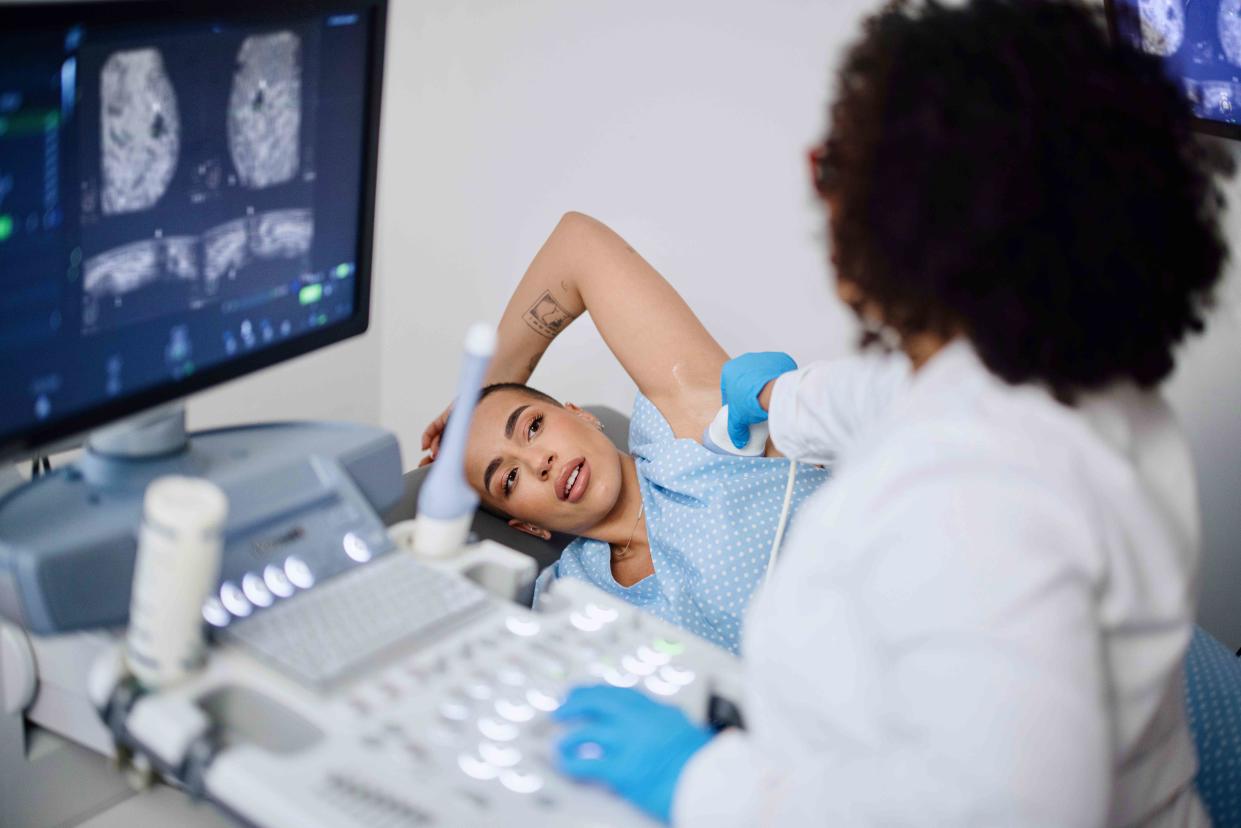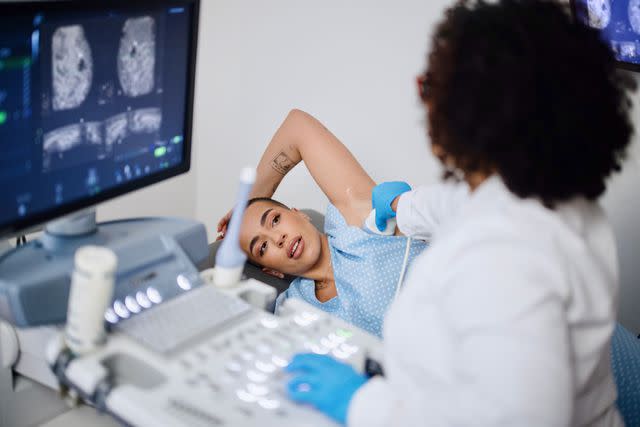Follow-Up Breast Cancer Imaging Costs Deter People From Getting Care, Study Finds

Anchiy/Getty Images
Fact checked by Nick Blackmer
About 1 in 5 patients surveyed said that if they received abnormal mammogram results, they would not go in for follow-up imaging if they had to pay a deductible.
Most abnormal mammograms are false positives, experts said, but additional follow-up imaging tests are necessary to determine if someone has early-stage breast cancer.
These high deductibles or other fees exacerbate existing health disparities and deter people from getting the preventative breast cancer care they need, experts said.

Anchiy/Getty Images
A significant percentage of patients—about 21%—say that they would skip follow-up breast imaging after an abnormal mammogram if they had to pay a deductible, new research shows.
The study, published on April 4 in Radiology, asked about 700 participants if, in a hypothetical situation, they would forgo this additional imaging to confirm whether they had breast cancer. The high percentage of people who said they would illustrates how cost is often a barrier for breast cancer screenings and diagnoses, experts said.
“We do know that people’s decision to use health care is sensitive to the cost that they pay out of pocket for that care,” Anna Sinaiko, PhD, assistant professor of health economics and policy at Harvard T.H. Chan School of Public Health, told Health. “If you raise costs for patients, they do use less care, even when it's needed and appropriate.”
Here’s what experts had to say about why such a significant portion of patients may be skipping breast cancer imaging, why that’s cause for concern, and what to do in the face of high costs.
Additional Costs Deter People From Seeking Breast Cancer Imaging
Currently, if a person goes in to get a mammogram, it will most likely be at no cost to them. This is thanks to an Affordable Care Act (ACA) rule which requires insurance companies to provide one free mammogram annually, as they’re deemed a “preventative service.”
But if a person gets their mammogram results back and their health care provider spots something abnormal, they’ll be called for additional imaging. This is where things can get expensive.
“Once they find something and they want you to come back and get an additional imaging exam, that might be mammogram, but often it’s ultrasound or MRI or some other kind of imaging. Then that no longer is called a screening test,” Karen Kuntz, ScD, professor of health policy and management at the University of Minnesota School of Public Health, told Health. “It’s a diagnostic test. And so now that can trigger a co-payment.”
Hoping to investigate the effect of these additional imaging costs, researchers gave a survey to patients at Boston Medical Center between September 2021 and February 2022.
There were 714 people who answered the survey question, “If I knew that I had to pay a deductible for the additional imaging [to make sure my screening mammogram is normal], I would skip this additional imaging.” About 21% of the respondents said that they would, and nearly 60% said they wouldn’t consider skipping the follow-up imaging.
Additionally, 707 participants answered a question on whether they would skip breast cancer screening altogether if they knew that they’d have to pay a deductible for follow-up tests later on. About 18% said they would skip this initial screening mammography, while about 66% said they would not.
Besides those who gave a yes or no to each hypothetical statement, a significant portion of people said they weren’t sure what they would do—another 20% said they were undecided on whether they would skip a follow-up imaging after an abnormal mammogram, and 16% said they didn’t know if they would skip initial mammography.
This could indicate that the actual number of people who end up avoiding these follow-up tests and screenings is even higher.
The study also found that certain demographic groups were more likely to skip breast imaging than others. In line with pre-existing health disparities, people who were less-educated, had a lower income, were not white, and had Medicaid or no insurance were most likely to avoid both mammography and additional breast imaging due to cost.
“It’s going to increase disparities in breast cancer outcomes, which is what we don’t want,” Kuntz said.
The study does have a few limitations, experts explained. Since there were only a few hundred participants, the results may not reflect the sentiments of the entire U.S. population who are eligible for mammograms. Also, the researchers asked patients to explain their behavior in a hypothetical situation, which could mean they’d act differently when faced with an actual abnormal mammogram and high deductible.
Still, the study’s findings seem to be in line with what researchers already know. A study published last year found that about 20% of people did not return for their follow-up examination after receiving inconclusive mammogram results. And the problem is apparent outside of breast cancer screening, too—about 40% of survey respondents reported skipping a recommended medical test or treatment because they were worried about cost.
Related:Nearly 50% of Women Skip Preventative Health Appointments—Here Are the Checkups to Prioritize
The Importance of Follow-Up Imaging for Early Detection
Receiving abnormal mammogram results is fairly common, said Therese Bevers, MD, medical director of the Cancer Prevention Center at the University of Texas MD Anderson Cancer Center. But it’s always better to be safe.
“While 80% [of abnormal mammograms] are not breast cancer, 20% are,” Dr. Bevers told Health. “Where do the two intersect? How many of the 20% of breast cancers are going to be in that one of five women who elect to not get the further workup? And so then things progress, and she’s ultimately diagnosed at a more advanced stage.”
This is precisely what healthcare providers are trying to avoid, Sinaiko explained.
“Cancer outcomes are a lot better the earlier it is detected,” she said. “We want patients to go for their mammograms to be screened so that we can catch the disease as early as possible, then it just leads to better survival and quality of life.”
The findings are also concerning because they raise the question of whether skipping care is common practice even after people get diagnosed with breast cancer, said Sarah Tevis, MD, assistant professor of surgery at the University of Colorado Anschutz Medical Campus.
“If it’s such a barrier that they can’t even get [screened] to get diagnosed, are they going to be able to afford to follow through with the treatment recommendations that we provide?” she told Health.
Related:MRIs May Detect Cancer in Dense Breasts Better Than Mammograms—Should You Get One?
What People Can Do to Get Their Breast Imaging Costs Down
Though it’s important for people to commit to additional breast cancer imaging if necessary, it can be hard to quantify the cost. For one, the cost often depends on the type of imaging a provider orders, the experts said.
“They could maybe just need a diagnostic mammogram that reassures the radiologist that there’s nothing concerning going on,” Dr. Tevis said. “Or they could need a mammogram and an ultrasound and a biopsy and an MRI.”
If more intensive exams are required, she explained, that’s where the costs could become quite significant.
What the patient themselves is responsible for paying also depends on if they have health insurance, and the type that they have.
If the additional breast imaging falls under someone’s deductible, Sinaiko explained, they will have to pay the full cost. It may be less expensive if a person has a copay or coinsurance, where they’ll pay a flat fee or a percentage of the cost, respectively.
In addition to the cost of the care itself, patients may be discouraged from going to their follow-up if they have to find childcare, travel long distances, or take time off work, Dr. Tevis added.
“As you start to think about the different financial barriers to getting that further workup, you can see why some women may find that prohibitive,” Dr. Tevis said. “I’ve seen women who don’t have insurance and who can’t afford their screening exams who have come in with a breast cancer diagnosis that probably would have been picked up on a screening mammogram.”
Lowering costs may be a matter of simply redefining what is considered a preventative screening test versus a diagnostic test. If follow-up appointments were considered the former rather than the latter, public and private insurance would likely cover them.
“The intent of the screening mammogram is early detection,” Dr. Bevers said. “Just getting the screening mammogram isn’t enough. You’ve got to complete the workup. And so the workup really is part of the screening.”
Covering preventative care is also to the benefit of groups such as insurance companies and employers, Sinaiko added, since it increases the odds that someone will need less aggressive care down the road if their cancer is caught early.
But for now, experts agree that people should make a plan for what they should do if they were to need a follow-up breast exam. They can call and ask their insurance provider to spell out what exactly is covered, Kuntz said, and they may want to consider shopping around to see if they can find better coverage for these follow-up tests, Sinaiko added. Healthcare facilities may also have financial counselors or other resources that people can take advantage of, Dr. Tevis said.
Beyond the individual level, however, real change in the costs associated with follow-up breast imaging may need to come from a higher level. This could include everything from legislative pressures on insurance companies, to raising awareness of the importance of attending these types of appointments, experts agree.
Covering that initial screening mammography is a huge step in the right direction, but patients need to be in a position where they can actually determine whether they have breast cancer.
“People are becoming more and more aware that, ‘Oh, this is great that we’re covering the screening tests, but we have to cover all of the follow-up tests as well,’” Kuntz said. “Otherwise, there’s no effectiveness—[there’s] no upside to doing that first test if you can’t do the follow-up.”
Related:How To Fight Medical Bills
For more Health news, make sure to sign up for our newsletter!
Read the original article on Health.

